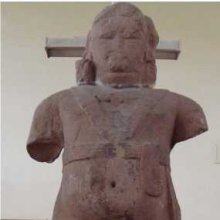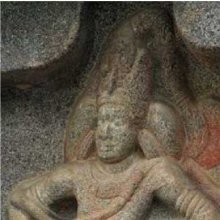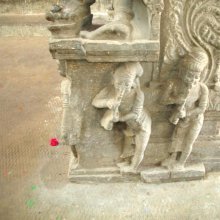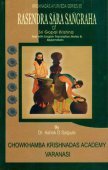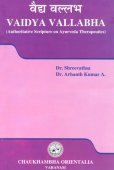Udara, Udāra: 35 definitions
Introduction:
Udara means something in Buddhism, Pali, Hinduism, Sanskrit, Jainism, Prakrit, the history of ancient India, Marathi, Hindi. If you want to know the exact meaning, history, etymology or English translation of this term then check out the descriptions on this page. Add your comment or reference to a book if you want to contribute to this summary article.
Alternative spellings of this word include Udar.
Images (photo gallery)
In Hinduism
Ayurveda (science of life)
Source: Wisdom Library: Āyurveda and botanyUdara (उदर) refers to “abdomen”, “womb” or “stomach”. The literal translation is “cavity”, “hollow” or “the interior or inside of anything”. The term is used throughout Ayurvedic literature such as the Suśruta-saṃhitā and the Caraka-saṃhitā.
Source: archive.org: Vagbhata’s Ashtanga Hridaya Samhita (first 5 chapters)Udara (उदर) refers to “abdominal swellings”, as mentioned in verse 5.11-12, 13-14, 25 of the Aṣṭāṅgahṛdayasaṃhitā (Sūtrasthāna) by Vāgbhaṭa.—Accordingly, “[...] (those) [rivers, viz., nadī] rising with the Prācyas, Avantis, and Aparāntas [produce] hemorrhoids; (those) [rivers] coming from the Mahendra [produce] abdominal swellings [udara], elephantiasis, and indisposition; [...]”.
Source: gurumukhi.ru: Ayurveda glossary of termsUdara (उदर):—[udaram] Abdomen

Āyurveda (आयुर्वेद, ayurveda) is a branch of Indian science dealing with medicine, herbalism, taxology, anatomy, surgery, alchemy and related topics. Traditional practice of Āyurveda in ancient India dates back to at least the first millenium BC. Literature is commonly written in Sanskrit using various poetic metres.
Natyashastra (theatrics and dramaturgy)
Source: Wisdom Library: Nāṭya-śāstra1) Udara (उदर) refers to the “belly”. It is one of the parts of the human body with which gestures (āṅgika) are performaned, according to the Nāṭyaśāstra chapter 8. These gestures form a part of the histrionic representation (abhinaya).
There are three ‘movements of the belly’ (udara) defined:
- kṣāma (thin),
- khalva (depressed),
- pūrṇa (full).
2) Udāra (उदार, “exaltedness”) or Udāratā refers to one of the ten merits (guṇa) of a dramatic play (kāvya), according to Nāṭyaśāstra chapter 17. They are characterised by their sweetness and depth of meaning.
Source: archive.org: Natya ShastraUdāra (उदार, “exaltedness”).—One of the ten guṇas (merits) of a kāvya (dramatic play);—Description of udāra: When the composition includes witty and graceful words having many special senses which are marvellous, it is an instance of Exaltedness (udātta, lit. “deep”).
Source: Shodhganga: The significance of the mūla-beras (natya)Udara (उदर, “stomach”) refers to one of the nine “minor limbs” (pratyaṅga), which represents a division of Āṅgikābhinaya (gesture language of the limbs) as used within the classical tradition of Indian dance and performance, also known as Bharatanatyam.—Āṅgika-abhinaya is the gesture language of the limbs. Dance is an art that expresses itself through the medium of body, and therefore, āṅgikābhinaya is essential for any dance and especially for any classical dance of India. Pratyaṅgas or the minor limbs consist of shoulders, shoulder blades, arms, back, [Stomach, viz., Udara], thighs and calves; at times the wrists, knees and elbows are also counted among minor limbs.

Natyashastra (नाट्यशास्त्र, nāṭyaśāstra) refers to both the ancient Indian tradition (shastra) of performing arts, (natya—theatrics, drama, dance, music), as well as the name of a Sanskrit work dealing with these subjects. It also teaches the rules for composing Dramatic plays (nataka), construction and performance of Theater, and Poetic works (kavya).
Dharmashastra (religious law)
Source: Google Books: Manusmṛti with the ManubhāṣyaUdāra (उदार).—One whose body is free from defects is called ‘avyaṅgāṅgī’; the term ‘avyaṇga’ standing for freedom from defects; just like such other words as ‘pravīṇa’, ‘udāra’ and the rest.

Dharmashastra (धर्मशास्त्र, dharmaśāstra) contains the instructions (shastra) regarding religious conduct of livelihood (dharma), ceremonies, jurisprudence (study of law) and more. It is categorized as smriti, an important and authoritative selection of books dealing with the Hindu lifestyle.
Shaktism (Shakta philosophy)
Source: Google Books: Manthanabhairavatantram1) Udara (उदर) refers to the “container” (e.g., of the world), according to the Manthānabhairavatantra, a vast sprawling work that belongs to a corpus of Tantric texts concerned with the worship of the goddess Kubjikā.—Accordingly, “The state of the Gander [i.e., haṃsagati] (arises) when all the energies (of the Moon) have dissolved away. The container of the world of the Gander [i.e., udara—bhuvanasya tu haṃsasya udaraṃ] is the first energy (of the Moon). Fierce (caṇḍā) she is Umā, the New Moon who illumines consciousness. The awakening of Kaula is its manifestation (udaya) (as) the deity of the group of six (Wheels). The deity is in the Tradition of the Cave and it is she who, by means (of her) modalities, is in the six (Wheels)”.
2) Udara (उदर) refers to the “stomach”, which is associated with the Somagranthi, according to the Ṣaṭsāhasrasaṃhitā, an expansion of the Kubjikāmatatantra: the earliest popular and most authoritative Tantra of the Kubjikā cult.—Accordingly, “ (8) (The Knot) called Brahmā is in the penis (svādhiṣṭhāna) and (9) the Knot of the Moon (soma) is in the stomach [i.e., udara]. [...]”.

Shakta (शाक्त, śākta) or Shaktism (śāktism) represents a tradition of Hinduism where the Goddess (Devi) is revered and worshipped. Shakta literature includes a range of scriptures, including various Agamas and Tantras, although its roots may be traced back to the Vedas.
Vastushastra (architecture)
Source: Brill: Śaivism and the Tantric Traditions (architecture)Udara (उदर) refers to the “belly ”, according to the Devyāmata (in the section śalyoddhāra-paṭala or “excavation of extraneous substances”).—Accordingly, “[...] If [someone] touches his back, there is [an extraneous thing] arising from the back (pṛṣṭhaja) [, i.e. a back-bone at the depth up to the back]. If [someone touches] his belly (udara), [there is an extraneous thing related to the belly] at the depth up to the [belly]. If [someone] touches his side, one should prognosticate that there is an extraneous thing arising from dust. The best knower of extraneous things [= the officiant] should remove that extraneous thing which exists [at a depth of] that measurement [= up to the side] [underground]. [...]”.

Vastushastra (वास्तुशास्त्र, vāstuśāstra) refers to the ancient Indian science (shastra) of architecture (vastu), dealing with topics such architecture, sculpture, town-building, fort building and various other constructions. Vastu also deals with the philosophy of the architectural relation with the cosmic universe.
Shaivism (Shaiva philosophy)
Source: SOAS University of London: Protective Rites in the Netra TantraUdara (उदर) refers to the “belly” (of the moon), according to the Netratantra of Kṣemarāja: a Śaiva text from the 9th century in which Śiva (Bhairava) teaches Pārvatī topics such as metaphysics, cosmology, and soteriology.—Accordingly, [verse 2.22cd-28ab]—“From this authority, the seventy-million mantras arise. The terminal letter shining with various light, [which is the] split belly of the moon (śaśāṅka-śakala-udara) [j], is placed upon a hook [u], and yoked with the last rising horizon [i.e., the wind or last labial nasalization] [ṃ]. That which is described is celebrated in the world as the supreme Amṛta [sa], this is the highest dwelling place. [...]”.

Shaiva (शैव, śaiva) or Shaivism (śaivism) represents a tradition of Hinduism worshiping Shiva as the supreme being. Closely related to Shaktism, Shaiva literature includes a range of scriptures, including Tantras, while the root of this tradition may be traced back to the ancient Vedas.
Yoga (school of philosophy)
Source: ORA: Amanaska (king of all yogas): A Critical Edition and Annotated Translation by Jason BirchUdara (उदर) refers to the “stomach”, according to the Dattātreyayogaśāstra verse 35-38ab.—Accordingly, while describing the lotus pose (padmāsana): “Having carefully placed the upturned feet on the thighs and the upturned hands in between the thighs, [the Yogin] should fix the eyes on the tip of the nose. Having lifted the uvula with the tongue; having fixed the chin on the chest and having drawn in the breath slowly according to his capacity, he should fill [the region of] the stomach (udara). After that, he should exhale the breath slowly according to his capacity. This is said to be padmāsana, which destroys all diseases”.

Yoga is originally considered a branch of Hindu philosophy (astika), but both ancient and modern Yoga combine the physical, mental and spiritual. Yoga teaches various physical techniques also known as āsanas (postures), used for various purposes (eg., meditation, contemplation, relaxation).
General definition (in Hinduism)
Source: Wisdom Library: HinduismUdāra (उदार) is a Sanskrit word referring to “exalted”, “upright” or “energetic”.
In Buddhism
Mahayana (major branch of Buddhism)
Source: Wisdom Library: Maha Prajnaparamita Sastra1) Udara (उदर, “belly”) is one of the parts of the human body from which the Buddha emitted numerous rays when he smiled with his whole body after contemplating the entire universe, according to the 2nd century Mahāprajñāpāramitāśāstra (chapter XIV).—Accordingly, having himself arranged the lion-seat, the Bhagavat sat down cross-legged; holding his body upright and fixing his attention, he entered into the samādhirājasamādhi. Then, having tranquilly come out of this samādhi and having contemplated the entire universe with his divine eye (divyacakṣus), the Bhagavat smiled with his whole body. Wheels with a thousand spokes imprinted on the soles of his feet (pādatala) shoot out six hundred prabhedakoṭi of rays. In the same way, beams of six hundred prabhedakoṭi of rays are emitted from his belly (udara).
2) Udara (उदर, “belly”) (Pali, Usatiya) refers to one of the thirty-substances of the human body according to the Visuddhimagga, as mentioned in an appendix of the 2nd century Mahāprajñāpāramitāśāstra chapter 32-34. The Mahāprajñāpāramitāśāstra mentions thirty-six substances [viz., udara]; the Sanskrit sources of both the Lesser and the Greater Vehicles, physical substances are 26 in number while the Pāli suttas list thirty-once substances.
Source: De Gruyter: A Buddhist Ritual Manual on AgricultureUdāra (उदार) or Udārabali refers to an “sumptuous (offering)”, according to the 2nd-century Meghasūtra (“Cloud Sutra”) in those passages which contain ritual instructions.—Accordingly, “[...] with [this] ‘Heart of the snakes;’ the cloud-monarchs too must be depicted, emitting a shower, and rubbing against one another; at the end masses of rain-birds and lightning are to be painted; and parched rice canopied by the swastika, also fish and flesh, and honey-food without curds, and a sumptuous offering (udāra—udāraścātra baliḥ) must be made there. [...]”

Mahayana (महायान, mahāyāna) is a major branch of Buddhism focusing on the path of a Bodhisattva (spiritual aspirants/ enlightened beings). Extant literature is vast and primarely composed in the Sanskrit language. There are many sūtras of which some of the earliest are the various Prajñāpāramitā sūtras.
Tibetan Buddhism (Vajrayana or tantric Buddhism)
Source: BDK Tripiṭaka: The Susiddhikara-sūtraUdāra (उदार) refers to “great food”, as mentioned in Chapter 12 (“offering food”) of the Susiddhikara-sūtra. Accordingly, “If among the oblation rites you see one that uses ‘kāmika (desirable) food,’ you should offer svastika cakes, ulopika (?) cakes, and other dishes prepared to the best of your ability: these include [dishes with] granular sugar, boiled rice mixed with curds, roots, fruits, and milk gruel. This kāmika food is suitable for offering in all instances except ābhicāruka [rites]. If among the oblation rites you see one that uses ‘vicitra (variegated) food,’ add to the kāmika food two or three kinds of food different from the above: this is [vicitra food]. If among the oblation rites you see one that uses ‘udāra (great) food,’ double the above kāmika food and set out large quantities: this is [udāra food]”.
Source: OSU Press: Cakrasamvara SamadhiUdara (उदर) or “stomach” is associated with Subhadrā and Vajrabhadra, according to the Cakrasaṃvara-maṇḍala or Saṃvaramaṇḍala of Abhayākaragupta’s Niṣpannayogāvalī, p. 45 and n. 145; (Cf. Cakrasaṃvaratantra, Gray, David B., 2007).—The Cakrasaṃvara mandala has a total of sixty-two deities. [...] Three concentric circles going outward, the body, speech and mind wheels (kāya-vāka-citta), in the order: mind (blue), speech (red), and body (white), with eight Ḍākinīs each in non-dual union with their Ḍākas, "male consorts".
Associated elements of Subhadrā and Vajrabhadra:
Circle: vākacakra [=vākcakra?] (speech-wheel) (red);
Ḍākinī (female consort): Subhadrā;
Ḍāka (male consort): Vajrabhadra;
Bīja: laṃ;
Body-part: throat;
Pīṭha: Lampāka;
Bodily constituent: udara (stomach);
Bodhipakṣa (wings of enlightenment): prajñābala (power of wisdom).

Tibetan Buddhism includes schools such as Nyingma, Kadampa, Kagyu and Gelug. Their primary canon of literature is divided in two broad categories: The Kangyur, which consists of Buddha’s words, and the Tengyur, which includes commentaries from various sources. Esotericism and tantra techniques (vajrayāna) are collected indepently.
In Jainism
General definition (in Jainism)
Source: The University of Sydney: A study of the Twelve Reflections1) Udara (उदर) refers to “inside” (a particular hell), according to the 11th century Jñānārṇava, a treatise on Jain Yoga in roughly 2200 Sanskrit verses composed by Śubhacandra.—Accordingly, “They fall from that place [and] immediately they enter the Rasātala hell. They roam about the whole world like the wind [and] they fall down into the Naraka hell (naraka-udara—viśvaṃ patanti narakodare). They fall from that place [and] immediately they enter the Rasātala hell. They roam about the whole world like the wind [and] they fall down into the Naraka hell”.
Synonyms: Madhya.
2) Udāra (उदार) refers to the “great (tree)” (that is stopping the influx of karma), according to the Jñānārṇava.—Accordingly, “Glory to the great tree that is stopping the influx of karma (saṃvaroddāmavṛkṣaḥ; var.—saṃvarodāravṛkṣaḥ) whose opponent is conquered, which is rooted in all the rules of conduct for a mendicant, whose great trunk is restraint, whose full branches are tranquillity, which is covered with the blossom of virtue [and] is beautiful because of producing whole fruit through the reflections. [Thus ends the reflection on] stopping the influx of karma”.
Synonyms: Uddāma, Utkaṭa.

Jainism is an Indian religion of Dharma whose doctrine revolves around harmlessness (ahimsa) towards every living being. The two major branches (Digambara and Svetambara) of Jainism stimulate self-control (or, shramana, ‘self-reliance’) and spiritual development through a path of peace for the soul to progess to the ultimate goal.
India history and geography
Source: Cologne Digital Sanskrit Dictionaries: Indian Epigraphical GlossaryUdāra.—(CII 1), a person of high rank; a rich man. Note: udāra is defined in the “Indian epigraphical glossary” as it can be found on ancient inscriptions commonly written in Sanskrit, Prakrit or Dravidian languages.

The history of India traces the identification of countries, villages, towns and other regions of India, as well as mythology, zoology, royal dynasties, rulers, tribes, local festivities and traditions and regional languages. Ancient India enjoyed religious freedom and encourages the path of Dharma, a concept common to Buddhism, Hinduism, and Jainism.
Languages of India and abroad
Pali-English dictionary
Source: BuddhaSasana: Concise Pali-English Dictionaryudara : (nt.) bell; stomach; interior. || udāra (adj.), noble; excellent; great; lofty.
Source: Sutta: The Pali Text Society's Pali-English DictionaryUdāra, (adj.) (Sk. udāra, of which the usual P. form is ulāra (q. v.). Cp. BSk. audāra & audārika. ) raised, sublime, noble, excellent Dāvs III, 4 (samussit-odāra-sitātapattaṃ); DA. I, 50 (°issariya); Sdhp. 429, 591. (Page 134)
— or —
Udara, (nt.) (Vedic udara, Av udara belly, Gr. u(ζteros = Lat. uterus belly, womb; Lith. védaras stomach, See also Walde, Lat. Wtb. under vensica) — 1 the belly, stomach D. II, 266; Sn. 78, 604, 609, 716; J. I, 146, 164, 265; Miln. 213; PvA. 283; KhA 57, 58; DhA. I, 47 (pregnant); Sdhp. 102.—2. cavity, interior, inside Dāvs. I, 56 (mandir-odare). —ūnûdara with empty belly Th. 1, 982; Miln. 406, 407; cp. ūna.

Pali is the language of the Tipiṭaka, which is the sacred canon of Theravāda Buddhism and contains much of the Buddha’s speech. Closeley related to Sanskrit, both languages are used interchangeably between religions.
Marathi-English dictionary
Source: DDSA: The Molesworth Marathi and English Dictionaryudara (उदर).—n (S) The abdomen or belly: also, popularly, the stomach. 2 Ascites, or enlargement of the abdomen from dropsy or flatulence: distinguished into jalōdara, vātōdara, matsyōdara, plīhōdara, sarpōdara, raktōdara. 3 Womb. Ex. mama udarā ālāsi sācāra || tariṃ kari ātāṃ mājhā uddhāra ||
--- OR ---
udāra (उदार).—a (S) Generous, munificent, bountiful. Pr. u0 tōca śrīmanta kṛpaṇa tōca daridrī. See Prov. x. 4, xi. 24, and xxii. 9. 2 Bold, ample, free; opp. to mean, pitiful, contracted, fettered; and applied variously: e. g. Bold, frank, liberal--speech, deportment: open, full, manly--features, countenance: broad, roomy, capacious--boats, vehicles, vessels.
Source: DDSA: The Aryabhusan school dictionary, Marathi-Englishudara (उदर).—n The belly, the stomach. Womb. Ascites.
--- OR ---
udāra (उदार).—a Generous, munificent, bountiful Bold, open
Marathi is an Indo-European language having over 70 million native speakers people in (predominantly) Maharashtra India. Marathi, like many other Indo-Aryan languages, evolved from early forms of Prakrit, which itself is a subset of Sanskrit, one of the most ancient languages of the world.
Sanskrit dictionary
Source: DDSA: The practical Sanskrit-English dictionaryUdara (उदर).—[ud-ṛ-ap]
1) The belly; दुष्पूरोदरपूरणाय (duṣpūrodarapūraṇāya) Bh. 2.119; cf. कृशोदरी, उदरभरणम्, उदरंभरि (kṛśodarī, udarabharaṇam, udaraṃbhari) &c.
2) The interior or inside of anything, cavity; तडाग° (taḍāga°) Pañcatantra (Bombay) 2.15; R.5.7; Uttararāmacarita 2.16,4.29; त्वां कारयामि कमलोदरबन्धनस्थम् (tvāṃ kārayāmi kamalodarabandhanastham) Ś.6.2; Śānti.1.5; Ś.1.19; Amaruśataka 88; जलदोदरेभ्यः (jaladodarebhyaḥ) Mṛcchakaṭika 5; Rs.3.12; घनानां वारिगर्भोदराणाम् (ghanānāṃ vārigarbhodarāṇām) Ś.7.7.
3) Enlargement of the abdomen from dropsy or flatulence; तस्य होदरं जज्ञे (tasya hodaraṃ jajñe) Ait. Br.
4) Any morbid abdominal affection, such as liver, spleen &c. (said to be of 8 kinds vāta°, pitta°, kapha°, triliṅga° or dūṣī°, plīhā°, baddhaguda°, āgantuka° and jala°).
5) Slaughter [cf. L. uterus; Zend. udara].
6) Battle.
--- OR ---
Udāra (उदार).—a.
1) Generous, liberal, munificent.
2) (a) Noble, exalted, dignified; स तथेति विनेतुरुदारमतेः (sa tatheti vineturudāramateḥ) R.8.91, 5.12; वाचः (vācaḥ) 65; उदाराः सर्व एवैते (udārāḥ sarva evaite) Bhagavadgītā (Bombay) 7.18. (b) High, lofty, great, best, illustrious, distinguished; °कीर्तेः (kīrteḥ) Kirātārjunīya 1.18; °तपसः (tapasaḥ) Bhartṛhari 3.51.
3) Honest, sincere, upright.
4) good, nice, fine; कृतः कटोभीष्म उदारः शोभनः (kṛtaḥ kaṭobhīṣma udāraḥ śobhanaḥ) Mahābhārata 2.3.1; उदारः कल्पः (udāraḥ kalpaḥ) Ś.5.
5) Proper, right.
6) Eloquent.
7) Kind, soft, agreeable; °वाचः कन्यकाः (vācaḥ kanyakāḥ) R.14.77.
8) Rich, plentiful; उदारा श्रीः स्थिता ह्यस्याम् (udārā śrīḥ sthitā hyasyām) Rām.4.22.16. उदारमभ्यवहारविधिम् (udāramabhyavahāravidhim) Daśakumāracarita 49; Mu.3.8.
9) Large, extensive, grand, splendid; साकेतोपवनमुदारमध्यु- वास (sāketopavanamudāramadhyu- vāsa) R.13.79; उदारनेपथ्यभृताम् (udāranepathyabhṛtām) 6.6 richly dressed.
1) Beautiful, charming, lovely; Kumārasambhava 7.14; Śiśupālavadha 5.21; see उदारदर्शन (udāradarśana) below; R.16.26,51.
11) Unperplexed.
12) Exciting, driving forth (Ved.). श्रीणामुदारो धरुणो रयीणाम् (śrīṇāmudāro dharuṇo rayīṇām) Ṛgveda 1.45.5.
-ram ind.
1) Loudly; प्रगीयते सिद्ध- गणैश्च योषितामुदारमन्ते कलभाविकस्वरैः (pragīyate siddha- gaṇaiśca yoṣitāmudāramante kalabhāvikasvaraiḥ) Śiśupālavadha 4.33.
2) By means of arguments; इति तानुदारमनुनीय (iti tānudāramanunīya) Kirātārjunīya 12.4.
-raḥ Ved.
1) A rising fog or vapour.
2) A sort of grain with long stalks.
3) A figure in Rhetoric which attributes greatness to inanimate objects.
Source: Cologne Digital Sanskrit Dictionaries: Edgerton Buddhist Hybrid Sanskrit Dictionary
Udāra (उदार).—adj. (= audāra, °rika; neither Sanskrit udāra nor Pali udāra, uḷāra, seems so used), coarse: Samādhirājasūtra 22.26 (verse) yasya codāra saṃjñādi nāmarūpasmi vartate, visabhāgāya saṃjñāya udāraṃ citta jāyate, if in the nāma-rūpa of someone there works a coarse saṃjñā etc., then, since this saṃjñā is not homogeneous [with the pure mind], the mind becomes coarse too (Régamey).
Source: Cologne Digital Sanskrit Dictionaries: Shabda-Sagara Sanskrit-English DictionaryUdara (उदर).—n.
(-raṃ) 1. The belly. 2. War. 3. Any morbid abdominal affection, as liver, spleen, &c. f. (-rī) Enlargement of the abdomen from dropsy or flatulency. E. ud up, ṛ to go, ap affix; what goes up or swells with food, slaughter, &c. or ud prefixed to dṛ to burst, and ac or al Unadi aff.
--- OR ---
Udāra (उदार).—mfn.
(-raḥ-rā-rī-raṃ) 1. Generous, liberal, munificent. 2. Great. 3. Unperplexed. 4. Gentle. 5. Upright, honest, sincere. 6. Eloquent. 7. Proper, right. E. ud well, āṅ prefixed to ṛ to go, and ap affixed.
Source: Cologne Digital Sanskrit Dictionaries: Benfey Sanskrit-English DictionaryUdara (उदर).—i. e. ud-ṛ + a, n. 1. The belly. 2. The interior part, [Bhartṛhari, (ed. Bohlen.)] 2, 26.
--- OR ---
Udāra (उदार).—i. e. ud-ṛ + a, adj., f. rā and rī, 1. Distinguished, [Nala] 1, 8. 2. Excellent, [Rāmāyaṇa] 1, 35, 8. 3. Great, Mahābhārata 3, 13158. 4. Gentle, [Rāmāyaṇa] 1, 33, 3. 5. Munificent, Dacak. in
Udara (उदर).—[neuter] (adj. —° [feminine] ā & ī) belly, womb, cavity, interior, inside; [locative] within, amidst (—°).
--- OR ---
Udāra (उदार).—[adjective] raising, causing; sublime, noble, excellent. [masculine] rising fog or mist; [plural] the spirits of the fog.
Source: Cologne Digital Sanskrit Dictionaries: Monier-Williams Sanskrit-English Dictionary1) Udara (उदर):—n. (√dṝ, [Uṇādi-sūtra v, 19]; √ṛ, [Boehtlingk & Roth’s Sanskrit-Woerterbuch] and, [Tārānātha tarkavācaspati’s Vācaspatyam, Sanskrit dictionary]), the belly, abdomen, stomach, bowels, [Ṛg-veda; Atharva-veda; Śatapatha-brāhmaṇa; Suśruta; Mahābhārata; Kathāsaritsāgara] etc.
2) the womb, [Mahābhārata; Viṣṇu-purāṇa; Caraka]
3) a cavity, hollow
4) the interior or inside of anything (udare, inside, in the interior), [Pañcatantra; Śakuntalā; Raghuvaṃśa; Mṛcchakaṭikā] etc.
5) enlargement of the abdomen (from dropsy or flatulence), any morbid abdominal affection (as of the liver, spleen etc.; eight kinds are enumerated), [Suśruta]
6) the thick part of anything (e.g. of the thumb), [Suśruta] [commentator or commentary] on [Yājñavalkya]
7) slaughter, [Naiṣadha-carita]
8) Udāra (उदार):—[=ud-āra] mf(ā and ī [gaṇa bahv-ādi, [Pāṇini 4-1, 45]])n. (√ṛ), high, lofty, exalted
9) [v.s. ...] mf(ā and ī)n. great, best
10) [v.s. ...] noble, illustrious, generous
11) [v.s. ...] upright, honest, [Mahābhārata; Śakuntalā; Śiśupāla-vadha] etc.
12) [v.s. ...] liberal, gentle, munificent
13) [v.s. ...] sincere, proper, right
14) [v.s. ...] eloquent
15) [v.s. ...] unperplexed, [cf. Lexicographers, esp. such as amarasiṃha, halāyudha, hemacandra, etc.]
16) [v.s. ...] exciting, effecting, [Ṛg-veda x, 45, 5]
17) [v.s. ...] active, energetic, [Sarvadarśana-saṃgraha]
18) [v.s. ...] m. rising fog or vapour (in some cases personified as spirits or deities), [Atharva-veda; Aitareya-brāhmaṇa]
19) [v.s. ...] a sort of grain with long stalks, [cf. Lexicographers, esp. such as amarasiṃha, halāyudha, hemacandra, etc.]
20) [v.s. ...] a figure in rhetoric (attributing nobleness to an inanimate object).
Source: Cologne Digital Sanskrit Dictionaries: Yates Sanskrit-English Dictionary1) Udara (उदर):—(raṃ) 1. m. The belly; war. (rī) 3. f. Enlargement of the abdomen from dropsy.
2) Udāra (उदार):—[udā+ra] (raḥ-rā-rī-raṃ) a. Generous, noble.
Source: DDSA: Paia-sadda-mahannavo; a comprehensive Prakrit Hindi dictionary (S)Udara (उदर) in the Sanskrit language is related to the Prakrit words: Uaa, Uara, Udara, Uyara, Urāla.
[Sanskrit to German]
Sanskrit, also spelled संस्कृतम् (saṃskṛtam), is an ancient language of India commonly seen as the grandmother of the Indo-European language family (even English!). Closely allied with Prakrit and Pali, Sanskrit is more exhaustive in both grammar and terms and has the most extensive collection of literature in the world, greatly surpassing its sister-languages Greek and Latin.
Hindi dictionary
Source: DDSA: A practical Hindi-English dictionary1) Udara (उदर) [Also spelled udar]:—(nm) abdomen, stomach; -[vṛddhī] dropsy; ~[stha] devoured, swallowed, eaten; abdominal; [udarīya] abdominal.
2) Udāra (उदार) [Also spelled udar]:—(a) generous, liberal; magnificent; ~[cetā, ~ manaska, ~manā] noble-minded, magnanimous, open-minded; ~[hṛdaya] liberal, noble-minded, open-minded; hence ~[hṛdayatā] (nf).
...
Prakrit-English dictionary
Source: DDSA: Paia-sadda-mahannavo; a comprehensive Prakrit Hindi dictionaryUdara (उदर) in the Prakrit language is related to the Sanskrit word: Udara.
Prakrit is an ancient language closely associated with both Pali and Sanskrit. Jain literature is often composed in this language or sub-dialects, such as the Agamas and their commentaries which are written in Ardhamagadhi and Maharashtri Prakrit. The earliest extant texts can be dated to as early as the 4th century BCE although core portions might be older.
Kannada-English dictionary
Source: Alar: Kannada-English corpusUdara (ಉದರ):—
1) [noun] the lower front part of the human body between the chest and thighs; the belly.
2) [noun] the stomach a) the large, saclike organ of vertebrates into which food passes from the oesophagus or gullet for storage while undergoing the early processes of digestion; b) any of the separate sections of such a digestive organ, as in ruminants or all these sections collectively; c) any enlarged storage portion of the digestive cavity, as in invertebrates.
3) [noun] the interior or inside of anything.
4) [noun] ಉದರ ನಿಮಿತ್ತಂ ಬಹುಕೃತ ವೇಷಂ [udara nimittam bahukrita vesham] udara nimittam bhukřta vēṣam (prov.) all one does is to fill the belly; the belly teaches all arts.
--- OR ---
Udāra (ಉದಾರ):—
1) [adjective] very generous in giving; characterised by great generosity; generous; munificent; liberal; benevolent.
2) [adjective] noble; dignified.
3) [adjective] honest; sincere; upright.
4) [adjective] large; extensive.
5) [adjective] proper; right.
6) [adjective] beautiful; charming.
--- OR ---
Udāra (ಉದಾರ):—
1) [noun] (rhet.) a figure of speech attributing greatness to inanimate objects.
2) [noun] (rhet.) richness and politeness in expression.
--- OR ---
Ūdara (ಊದರ):—
1) [noun] the vaporous matter arising from something burning and made visible by minute particles of carbon suspended in it; smoke.
2) [noun] 'a swelling esp. an abnormally swollen part of the body: 3) any undesired, uncultivated plant, esp. one growing in profusion so as to crowd out a desired crop, disfigure a lawn, etc.; a weed.'3) [noun] the grass Echinochloa colonum of Poaceae family; a kind of wild millet.
4) [noun] ಊದರಹಾಕು [udarahaku] ūdarahāku to cause smoke to rise (by burning something).
Kannada is a Dravidian language (as opposed to the Indo-European language family) mainly spoken in the southwestern region of India.
See also (Relevant definitions)
Starts with (+126): Udara-bandhana, Udara-gaddi, Udara-nwewe, Udarabali, Udarabandha, Udarabharana, Udarabharanamatrakevalecchu, Udarabhava, Udaracarita, Udaracarite, Udaracem Potem, Udaraceta, Udaracetas, Udaracharita, Udarachetas, Udaradara, Udaradari, Udaradarshaka, Udaradarshana, Udaradeva.
Ends with (+161): Abrudara, Accudara, Adavudara, Ahavaludara, Aivajudara, Alikasudara, Amadudara, Amaludara, Amdajudara, Antarikshodara, Anudara, Aparadhashudara, Apiludara, Atanudara, Atyudara, Audara, Babudara, Baddhodara, Baravardudara, Bastinibhodara.
Full-text (+282): Udarambhari, Anudara, Udaracetas, Urala, Jalodara, Udaraka, Udarata, Udaravirya, Mahodara, Damodara, Udaradhi, Udarasattvabhijana, Udaradarshana, Udaratva, Udarin, Audarya, Udarabhava, Udarakirti, Udaradhishana, Anyodarya.
Relevant text
Search found 68 books and stories containing Udara, Udāra, Ud-ara, Ud-āra, Ūdara; (plurals include: Udaras, Udāras, aras, āras, Ūdaras). You can also click to the full overview containing English textual excerpts. Below are direct links for the most relevant articles:
Rig Veda (translation and commentary) (by H. H. Wilson)
Garga Samhita (English) (by Danavir Goswami)
Verse 1.13.19 < [Chapter 13 - The Liberation of Pūtanā]
Verse 6.10.34 < [Chapter 10 - In the Description of the Gomatī River, the Glories of Cakra-tīrtha]
Verse 1.19.18 < [Chapter 19 - Breaking of the Two Arjuna Trees]
Vaisheshika-sutra with Commentary (by Nandalal Sinha)
Sūtra 10.1.7 (An objection answered) < [Chapter 1 - Of the Attributes of the Soul]
Bhajana-Rahasya (by Srila Bhaktivinoda Thakura Mahasaya)
Text 12 < [Chapter 4 - Caturtha-yāma-sādhana (Madhyāhna-kālīya-bhajana–ruci-bhajana)]
Text 6 < [Chapter 7 - Saptama-yāma-sādhana (Pradoṣa-kālīya-bhajana–vipralambha-prema)]
Text 16 < [Chapter 2 - Dvitīya-yāma-sādhana (Prātaḥ-kālīya-bhajana)]
Sahitya-kaumudi by Baladeva Vidyabhushana (by Gaurapada Dāsa)
Text 10.74 < [Chapter 10 - Ornaments of Meaning]
Text 9.40 [lotus diagram] < [Chapter 9 - Ornaments of Sound]
Text 4.16 < [Chapter 4 - First-rate Poetry]
The Garuda Purana (by Manmatha Nath Dutt)
Chapter CLXI - The Nidanam of Ascited etc < [Dhanvantari Samhita]
Chapter CC - Various other medicinal Recipes (continued) < [Dhanvantari Samhita]
Related products
